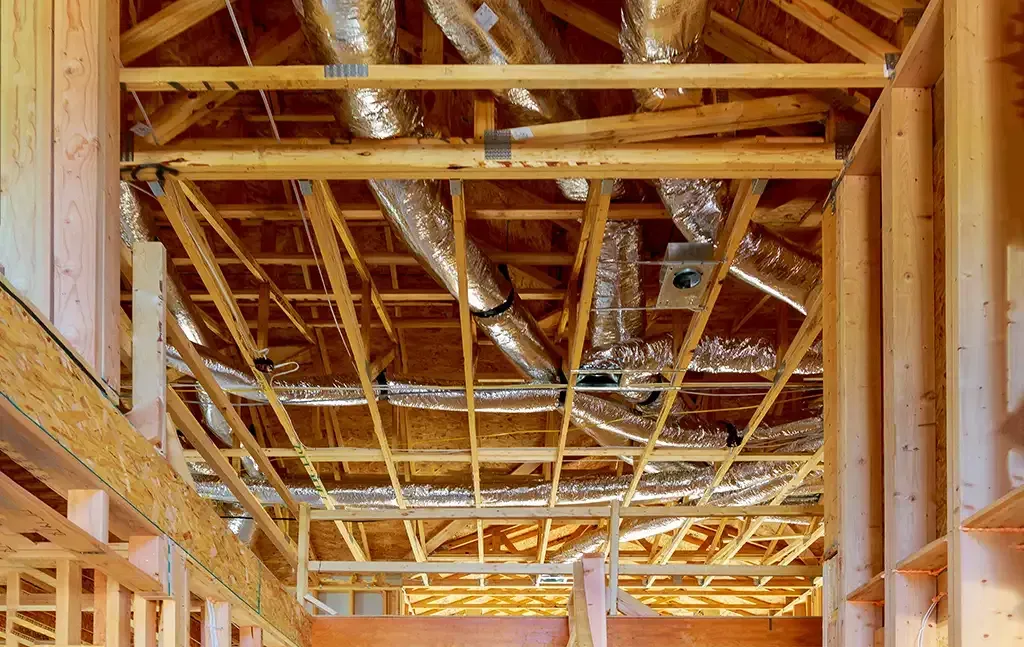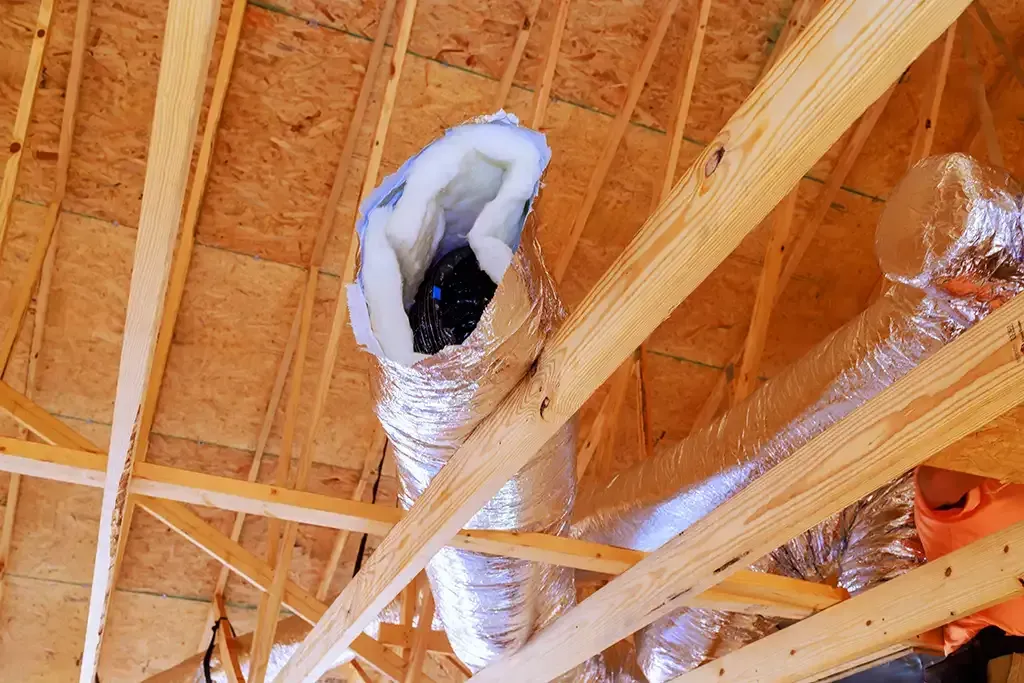Fix Air Leaks: How to Find and Seal Them in Your Home
Why Air Leaks Matter?
Want to know why it’s important to fix air leaks? Air leaks are like tiny holes in your home’s protection against the weather. They let cold air in during winter and allow cool air to escape in summer. This forces your heating and cooling systems to work harder, which wastes energy and costs you more money. In fact, air leaks can raise your energy bills by up to 20%!
Beyond money, air leaks affect your comfort. They create drafty areas and make some rooms feel too hot or too cold. They can also let in dust, pollen, and moisture that might make your family sick.
Finding and fixing these air leaks is one of the best ways to save energy and make your home more comfortable. The good news is that many fixes are simple and don’t cost much money.
Table of Contents
- Why Air Leaks Matter?
- Where Air Leaks Happen Most
- How to Find Air Leaks
- Easy DIY Fixes for Air Leaks
- When to Call the Professionals
- Keeping Your Home Sealed
- Fix Air Leaks: Common Questions
- Conclusion: Take Action to Fix Air Leaks Today
Where Air Leaks Happen Most
Air leaks can happen anywhere in your home, but some spots are more common than others:
Around Windows and Doors:
- Gaps between the frame and wall
- Worn-out weatherstripping
- Cracks in glass
- Spaces between moving parts
Wall Openings:
- Electrical outlets
- Where cables or pipes enter your home
- Dryer vents
- Outdoor water faucets

Attic and Basement Areas:
- Recessed lights
- Attic entrances
- Where walls meet the foundation
- Plumbing pipes going through floors or ceilings
Other Problem Areas:
- Fireplace dampers
- Mail slots
- Window air conditioners
- Where different building materials meet
Older homes usually have more leaks, but even new homes can develop problems over time. Knowing these common leak spots will help you find problems in your own home.
How to Find Air Leaks
Before you can fix air leaks, you need to find them. Here are some easy ways to spot leaks in your home:
Look Around Your Home
Start by simply looking for problems:
- Check for visible gaps around windows and doors
- Look for cracks in walls and ceilings
- See if you can spot daylight coming through the edges of doors and windows
- Check for missing caulk or weatherstripping
- Look for cobwebs, which often form in drafty spots
Use Your Hand
This simple test helps find drafty spots:
- Hold your hand near window frames, door edges, and outlets
- Feel for air movement on your skin
- You can also use a tissue or strip of toilet paper – it will flutter when there’s a draft
Try the Smoke Test
For a more detailed check:
- Close all windows and doors
- Turn off heating and cooling systems
- Turn on bathroom and kitchen fans
- Light an incense stick and move it slowly near suspected leak areas
- Watch the smoke – if it blows sideways instead of rising straight up, you’ve found a leak
Get a Professional Energy Audit
For the most complete check:
- Professional energy auditors use special tools like blower doors and infrared cameras
- They can find hidden leaks that are hard to spot yourself
- They give you a full report of all problems and how to fix them
Once you know where the leaks are, you can decide which ones to fix first. Usually, it’s best to start with the biggest and easiest-to-reach leaks.
Easy DIY Fixes for Air Leaks
Many air leaks can be fixed with simple tools and materials from your local hardware store. Here’s how to fix air leaks yourself:
Caulking
Caulk works great for sealing small cracks in places that don’t move:
- Best for: Window frames, door frames, and small wall cracks
- What you’ll need: Caulk gun and tube of caulk
- How to use it:
- Clean the area well
- Cut the tip of the caulk tube at an angle
- Apply a steady line of caulk
- Smooth it with your finger (wear gloves!)
- Let it dry completely
Weatherstripping
Weatherstripping is perfect for doors and windows that open and close:
- Best for: Door edges, window sashes, attic doors (see how)
- Types available:
- Foam tape (easy but doesn’t last long)
- V-strip (works well for windows)
- Door sweeps (for bottom of doors)
- Rubber gaskets (most durable)
- How to use it:
- Clean surfaces first
- Measure carefully before cutting
- Follow the package directions
- Test doors and windows after installing to make sure they still work properly
Foam Sealant
For bigger gaps, expanding foam works well:
- Best for: Larger holes around pipes and vents
- Tips:
- Wear gloves and eye protection
- Use small amounts (it expands a lot!)
- Choose the right type for your project
- Trim excess foam after it dries
Temporary Window Kits
For drafty windows in winter:
- What it is: Clear plastic film and double-sided tape
- How it works: The plastic creates an extra air barrier over the window
- Installation: Apply tape around window, attach plastic, use hair dryer to shrink and tighten
Outlet Gaskets
For electrical outlets on outside walls:
- What to do: Turn off power, remove plate cover, add foam gasket, replace cover
- Cost: About $10 for a pack that covers multiple outlets
Most DIY fixes cost between $5-$50 per project. These small investments can lead to big savings on your energy bills over time.
When to Call the Professionals
While many air leaks can be fixed on your own, some situations call for expert help to fix air leaks properly:
When to Get Professional Help
Consider calling a professional when:
- You’ve done the easy fixes, but still feel drafts
- You need to seal areas that are hard to reach
- Your energy bills remain unusually high
- You want the most thorough job possible
- You’re not comfortable doing home repairs
Professional Services Available
HVAC professionals like Economy Heating and Air can provide:
- Complete home energy audits to find every leak
- Specialized tools and materials not available to homeowners
- Duct sealing to fix hidden leaks in your heating and cooling system
- Proper ventilation solutions to ensure healthy air while stopping wasteful leaks

What to Expect
- If it’s been over 3 years since your last cleaning
- After home remodeling (which creates lots of dust)
- If you see signs of mold in your ducts
- When moving into a previously owned home
- If your family has severe allergies or asthma
Professional allergy duct cleaning usually costs between $300-$700 depending on your home size. For families with allergy problems, this cost is worth the relief it brings.
Keeping Your Home Sealed
Once you fix air leaks, keep your home sealed tight with these simple maintenance tips:
Seasonal Checks
Spring:
- Look for winter damage to caulk and weatherstripping
- Fix any problems before air conditioning season begins
Fall:
- Check seals again before heating season
- Add temporary window sealing if needed
- Make sure attic access points are sealed
Signs of New Problems
Watch for these warnings that new air leaks might have formed:
- Unexpected increases in energy bills
- New drafts or cold spots
- Doors that suddenly don’t close properly
- Increased dust in your home
Regular Maintenance
- Replace weatherstripping as it wears out
- Re-caulk areas that have cracked or pulled away
- Check for new gaps after storms or very hot/cold weather
- Inspect seals whenever you paint or repair your home
By staying on top of maintenance, you’ll keep your home efficient and comfortable year after year.
Fix Air Leaks: Common Questions
Q: How do I know if air leaks are really a problem in my home?
A: If you notice drafts, uneven temperatures between rooms, or unusually high energy bills, air leaks are likely an issue. A simple test is to hold a lit incense stick near windows and doors – if the smoke blows sideways instead of up, you have a leak.
Q: Will fixing air leaks make my home too airtight and cause air quality problems?
A: Most homes have plenty of natural ventilation even after sealing. If you’re concerned, using bathroom fans and kitchen vents regularly will ensure fresh air. Very tight homes might benefit from a ventilation system that brings in fresh air without wasting energy.
Q: What’s the difference between sealing air leaks and adding insulation?
A: Air sealing stops the flow of air through gaps and cracks. Insulation slows the transfer of heat through walls and ceilings. Both are important, but they work differently. Think of air sealing as fixing holes in a cup, while insulation is like making the cup’s walls thicker.
Q: What areas should I fix first when sealing air leaks?
A: Start with the biggest and easiest-to-reach leaks – usually around windows, doors, and obvious holes. These will give you the most savings for the least effort. Then move to attic leaks, since warm air rises and escapes upward.
Conclusion: Take Action to Fix Air Leaks Today
Air leaks might seem small, but they have a big impact on your energy bills and comfort. Taking time to find and fix air leaks is one of the best investments you can make in your home.
Whether you choose simple DIY fixes or professional help, any effort to seal leaks will pay off in a more comfortable home and lower energy costs. Start with the most obvious problems and work your way to the smaller ones.
Economy Heating and Air is here to help with professional energy audits, air sealing services, and expert advice for your home. Our experienced technicians can find hidden leaks and provide lasting solutions. Contact us today to schedule a home assessment and take the first step toward a more efficient, comfortable home environment.
Breathe Easy, Live Healthy
A comfortable home isn’t just about plush furniture or aesthetically pleasing decor. It’s also about creating a safe and healthy environment for all inhabitants. Prioritizing duct cleaning is integral in enhancing indoor air quality, paving the way for better health and overall well-being.
For those keen on elevating the air quality in their homes and reaping the numerous benefits of clean air ducts, don’t hesitate. Contact Economy Heating & Air to get the job done right and breathe a sigh of relief!

